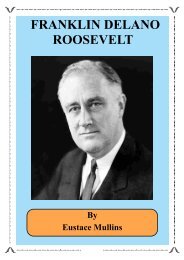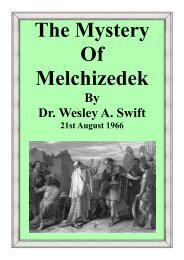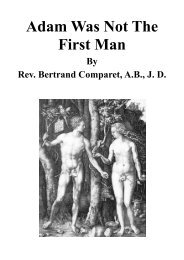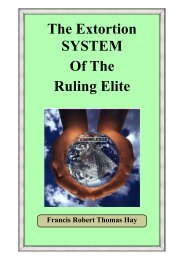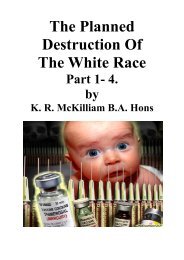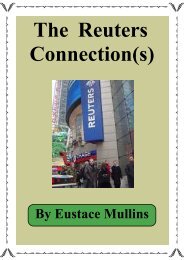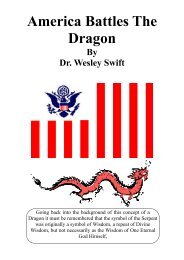Curse of Cannan - The New Ensign
Curse of Cannan - The New Ensign
Curse of Cannan - The New Ensign
You also want an ePaper? Increase the reach of your titles
YUMPU automatically turns print PDFs into web optimized ePapers that Google loves.
it could be republished today with virtually the same text. It would only need to be updated by<br />
including the names <strong>of</strong> the current conspirators. We know the name <strong>of</strong> Timothy Dwight as one<br />
<strong>of</strong> the three organizers <strong>of</strong> the Russell Trust at Yale, also known as Skull and Bones, or the<br />
Brotherhood <strong>of</strong> Death. <strong>The</strong> same small band <strong>of</strong> conspirators has figured in every plot to destroy<br />
the American Republic.<br />
<strong>The</strong> exposure <strong>of</strong> this conspiracy did not deter the plotters, who soon followed it with another,<br />
the Essex Junto <strong>of</strong> 1804-1808. <strong>The</strong> principal conspirators were born in or near Essex County,<br />
Massachusetts, hence the name <strong>of</strong> the plot. <strong>The</strong>y worked closely with agents <strong>of</strong> British<br />
Intelligence in Boston to bring about the secession <strong>of</strong> the <strong>New</strong> England states from the United<br />
States. <strong>The</strong>se Judases were no haggard, bomb-carrying revolutionaries; they were from the<br />
leading merchant and banking families <strong>of</strong> <strong>New</strong> England. <strong>The</strong>ir leader was Massachusetts Senator<br />
George Cabot, a direct descendant <strong>of</strong> the Genoese Cabot who had been commissioned by King<br />
Henry VII, and who had landed in Labrador almost two centuries earlier; other conspirators were<br />
Judge John Lowell, ancestor <strong>of</strong> the Bundy family <strong>of</strong> the Ford Foundation and other leading<br />
agencies; the Higginsons, Pickerings, Parsons, and Judge Tapping Reeve, <strong>of</strong> Litchfield,<br />
Connecticut, who happened to be Aaron Burr's brother-in-law. <strong>The</strong> conspiracy had been fueled<br />
by the efforts <strong>of</strong> a leading British Intelligence operative, Sir John Robison, who worked closely<br />
with the Aaron Burr network. After President Thomas Jefferson was informed <strong>of</strong> the details <strong>of</strong><br />
the Essex Junto, the malefactors reluctantly abandoned their dream <strong>of</strong> an early breakup <strong>of</strong> the<br />
Union, and then dedicated themselves to a longer-range strategy, which culminated in the Civil<br />
War.<br />
<strong>The</strong> British Secret Intelligence Service had been funded by Lord Shelburne to promote the<br />
interests <strong>of</strong> the East India Company, the Bank <strong>of</strong> England, <strong>of</strong> which it became the primary<br />
intelligence network, the banking families Hope and Baring, and their Swiss allies, the bankers<br />
Prevost and de Neuflize. <strong>The</strong>ir most able supporters in the United States were John Jacob Astor<br />
and Aaron Burr. Astor was treasurer <strong>of</strong> the Grand Lodge <strong>of</strong> <strong>New</strong> York from 1798-1800. In 1800,<br />
he was given free entry into all ports <strong>of</strong> the world which the East India Company had brought<br />
under their control. This gave him a tremendous financial advantage over his competitors. In<br />
return for this favorable treatment, he provided the financial backing for the plot to replace<br />
President Thomas Jefferson with Aaron Burr, after Jefferson had exposed the plot <strong>of</strong> the Essex<br />
Junto.<br />
Throughout the Revolutionary War, Burr had worked as a double agent, reporting daily to British<br />
forces from West Point. Burr later became attorney for the Astor interests, drawing up their<br />
contracts and doing commercial work for the East India Company. He routinely fixed elections<br />
in the <strong>New</strong> York area through his connections with the Masonic lodges. He had founded the<br />
Society <strong>of</strong> St. Tammany in <strong>New</strong> York City in 1789. It was set up symbolically with thirteen<br />
tribes, each <strong>of</strong> whom had a Grand Sachem at its head; the entire network was supervised by one<br />
Grand Sachem at the headquarters. This became the famous --or infamous-- Tammany Hall,<br />
which controlled the political structure <strong>of</strong> <strong>New</strong> York City for many years, rife with corruption<br />
and favouritism. It was never anything but a subsidiary <strong>of</strong> the Masonic lodges, <strong>of</strong> whom it was<br />
organized in open imitation.<br />
<strong>The</strong> head <strong>of</strong> the Masons in <strong>New</strong> York in 1783 had been rand Master William Walter, a British<br />
Army general. With the withdrawal <strong>of</strong> the British troops, he turned his leadership over to Robert<br />
Livingston, whose family connections included the Lees <strong>of</strong> Virginia and the Shippens <strong>of</strong><br />
Philadelphia (who were prominent in the Benedict Arnold scandal; Arnold had married Peggy<br />
Shippen). Robert Livingston was installed as Grand Master <strong>of</strong> the <strong>New</strong> York Lodge in 1884; his<br />
brother Edward was Mayor <strong>of</strong> <strong>New</strong> York. With these powerful allies supporting him from behind<br />
the scenes, Burr was able to conclude many successful financial deals. He easily obtained a<br />
charter for the Manhattan Company, with his registered purpose a plan to provide water for the<br />
city. No mains were ever built. Instead, he used the charter to start a bank, the Manhattan<br />
Company. This was later taken over by the investment firm <strong>of</strong> Kuhn, Loeb, Co., <strong>New</strong> York<br />
( Page 69)



